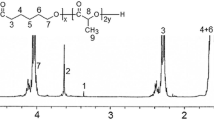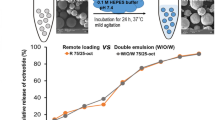Abstract
This paper describes the formulation of a biodegradable microparticulate drug delivery system containing clodronate, a bisphosphonate intended for the treatment of bone diseases. Microspheres were prepared with several poly(D,L-lactide-co-glycolide) (PLGA) copolymers of various molecular weights and molar compositions and 1 poly(D,L-lactide) (PDLLA) homopolymer by a water-in-oil-in-water (w/o/w) double emulsion solvent evaporation procedure. Critical process parameters and formulation variables (ie, addition of stabilizing agents) were evaluated for their effect on drug encapsulation efficiency and clodronate release rate from microparticles Well-formed clodronate-loaded microspheres were obtained for all polymers by selecting suitable process parameters (inner water/oil volume ratio 1∶16, temperature-raising rate in the solvent evaporation step 1°C/min, 2% wt/vol NaCl in the external aqueous phase). Good yields were obtained in all batches of clodronate microspheres (above 60%); drug encapsulation efficiencies ranged between 49% and 75% depending on the polymer used. Clodronate release from all copolymer microspheres was completed in about 48 hours, while those from PDLLA microspheres required about 20 days. The change of microsphere composition by adding a surfactant such as Span 20 or a viscosing agent such as carboxymethylcellulose extended the long-term release up to 3 months. Clodronate was successfully entrapped in PLGA and PDLLA microspheres, and drug release could be modulated from 48 hours up to 3 months by suitable selection of polymer, composition, additives, and manufacturing conditions.
Similar content being viewed by others
References
PD Delmas, PJ Meunier. The management of Paget's disease of bone. New Engl J Med. 1997;336:558–566.
JA Kanis. Rationale for the use of bisphosphonates in breast cancer. Acta Oncol. 1996;35(Suppl 5):61–67.
H Fleisch. Bisphosphonates: preclinical aspects and use in osteoporosis. Ann Med. 1997;29:55–62.
H Shinoda, G Adamek, R Felix, H Fleish, R Schenk. Structure-activity relationship of various bisphosphonates. Cale Tissue Int. 1983;35:87–99.
GJ Yakatan, WJ Poynor, RL Talbert, et al. Clodronate kinetics and bioavailability. Clin Pharmacol Ther. 1982;31:402–410.
L Lauren, T Osterman, T Karhi. Pharmacokinetics of clodronate after single intravenous, intramuscular and subcutaneous injections in rats. Pharmacol Toxicol. 1991;69:365–368.
M Rossini, D Gatti, D Gerardi, N Zamberlan, V Braga, S Adami. Intramuscular clodronate therapy in postmenopausal osteoporosis. Bone. 1999;24:125–129.
A Ezra, G Golomb. Administration routes and delivery systems of bisphosphonates for the treatment of bone resorption. Adv Drug Del Rev. 2000;42:175–195.
S Patashnik, L Rabinovich, G Golomb. Preparation and evaluation of chitosan microspheres containing bisphosphonates. J Drug Targ. 1997;4:371–380.
H Okada, H Toguchi. Biodegradable microspheres in drug delivery. Crit Rev Ther Drug Carrier Syst. 1995;12:1–99.
S Gogolewski, P Mainil-Varlet. Effect of thermal treatment on sterility, molecular and mechanical properties of various polylactides. Biomaterials. 1997;18:251–255.
S Cohen, T Yoshioka, M Lucarelli, LH Hwang, R Langer. Controlled delivery systems for proteins based on poly(lactic glycolic acid) microspheres. Pharm Res. 1991;8:713–720.
D Ostovic, C Stelmach, B Hulshizer. Formation of a chromophoric complex between alendronate and copper (II) ions. Pharm Res. 1993;10:470–472.
T Uchida, K Yoshida, S Goto. Preparation and characterization of polylactic acid microspheres containing water-soluble dyes using a novel w/o/w emulsion solvent evaporation method. J Microencapsul. 1996;13:219–228.
Y Ogawa, M Yamamoto, H Okada, T Yashiki, T Shimamoto. A new technique to efficiently entrap leuprolide acetate into microcapsules of polylactic acid or copoly (lactic glycolic) acid. Chem Pharm Bull. 1988;36:1095–1103.
RW Baker, Biodegradable systems. In: R Baker, ed.Controlled release of biologically active agents. New York: John Wiley & Sons; 1987:84–131
Author information
Authors and Affiliations
Corresponding author
Additional information
Published: July 11, 2001.
Rights and permissions
About this article
Cite this article
Perugini, P., Genta, I., Conti, B. et al. Long-term release of clodronate from biodegradable microspheres. AAPS PharmSciTech 2, 10 (2001). https://doi.org/10.1208/pt020310
Received:
Accepted:
DOI: https://doi.org/10.1208/pt020310




